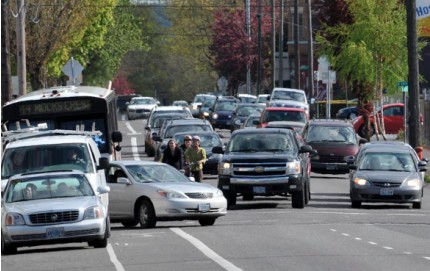
(Photos © J. Maus)
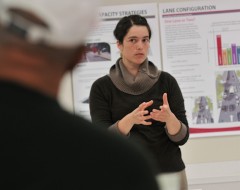
Stakeholder Advisory Committee meeting yesterday.
(Photos © J. Maus)
Several signs, including results from the recent North Williams Traffic Safety Operations project open house, point to growing community support for a cycle track and one motor vehicle lane (from the existing two) the entire length of Williams Avenue — including the dense commercial section between N Cook and Skidmore (a.k.a. Segment 4).
Surprisingly, PBOT’s current proposal is to do nothing to improve bike access in this busy section due to how it might impact motor vehicle capacity and based on fears that concerns of business owners and residents would make the project controversial.
“We definitely don’t want to do something that people will feel like will be bad for small businesses. That’s not going to carry at City Council.”
— Rob Burchfield, City Traffic Engineer
However, after a meeting of the Stakeholders Advisory Committee (SAC) yesterday, PBOT just might change their stance and officially consider having one lane of motor vehicle traffic in Segment 4 — thereby setting the stage for a greatly enhanced bikeway that would run all the way from Weidler to Killingsworth.
While project manager Ellen Vanderslice would not confirm with us that the one-lane option will be on the table (she said the issue is, “still under discussion internally”), many signs point toward growing political feasibility to make it happen.
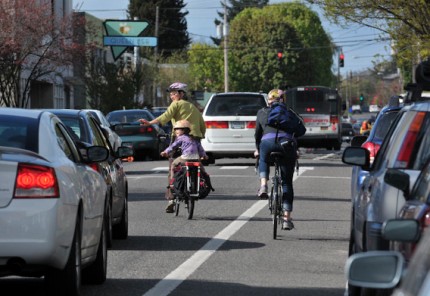
Results from the April 16th open house were made public at the meeting yesterday. Alta Planning and Design (the consultants on the project hired by PBOT) drafted a memo of the feedback received from the 117 people who came to the event and the 24 people who shared comments after viewing a “virtual open house” made available online.
Alta’s memo lists ten “key themes” from the feedback.
One of the key themes was to, “Re-examine the potential to improve bicycling conditions in Segment 4… With an enhanced bikeway.” It was also noted that Segment 4 received the most complaints about parking/loading/unloading in the bike lane, dooring, and “inadequate bike lane capacity.”
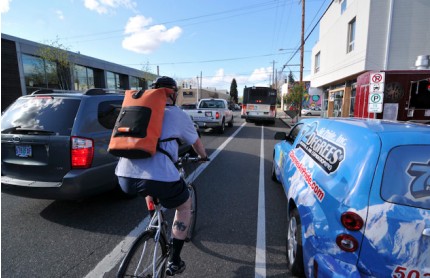
On the other side of the issue, the Alta memo also noted, “a number of business owners (and others)” in Segment 4 that, “were concerned about the possibility of reducing the amount of on-street parking.”
At the stakeholder meeting yesterday, several people spoke up to say they were not in favor of any reduction in auto lanes in Segment 4 (including, surprisingly, the owner of Cha! Cha! Cha! Taqueria); but when a straw poll was conducted, a large majority of committee members (10 out of 13 or so present according to my count) voted in support of putting forward a one-lane option (at this time, parking lane removal isn’t being considered).
Another sign of support for the one-lane option came from an unexpected source: real estate developers. Project consultants and PBOT met with developers who own property on N. Williams to get their take on the issue. SAC member Diana Moosman, who reprsents MOSI Architecture, told the committee that the developers, “Unanimously felt they would advocate for one-lane on Williams all the way.” (She also added they were not in favor of simply adding new traffic signals, which is PBOT’s current solution.)

This issue has also stirred up the advocacy community. Active Right of Way (AROW) has been a strong proponent of the one-lane option for several weeks now and the Bicycle Transportation Alliance (BTA) made their stance on the project clear with a blog post just this morning.
While momentum is clearly on the side of a one-lane Williams Avenue, what the actual bikeway ends up looking like remains to be seen.
At the open house, when people were asked which of the two bikeway options they preferred, a cycle track received 116 out of a total 188 votes compared to just 51 votes for an “enhanced (buffered) bikeway” and just 21 votes for leaving the existing bike lane as is.
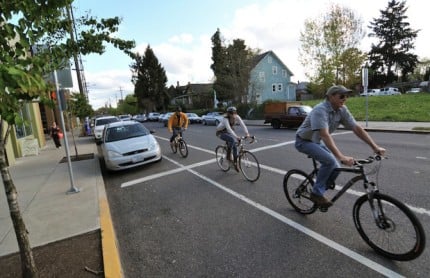
If the committee decides a cycle track is the preferred option, PBOT and Alta have already made it clear that there are many technical issues that could sink the idea. How would a curbside cycle track integrate with TriMet bus stops? Would ADA requirements be a deal-breaker? Could the Fire Bureau still access buildings? How would a cycle track be maintained?
There’s a technical advisory committee currently looking into those issues and is expected to report back soon.
One other hurdle remains for the one-lane/cycle track option.
City Traffic Engineer Rob Burchfield, made it clear at the meeting that businesses hold considerable sway in this process. Here’s how he responded to a question by project consultant Michelle Poyourow about his thoughts on the one-lane option:
“… What we definitely don’t want to do is have businesses upset that we’ve made it more difficult for people to get to their business. We don’t want that perception… if we’re going to go this way [one-lane], it has to be something that works for the local stakeholders, the businesses, and the people that live here… We definitely don’t want to do something that people will feel like will be bad for small businesses. That’s not going to carry at City Council.”
Project staff plans to hold a separate meeting with small business owners in the coming weeks to discuss their concerns.

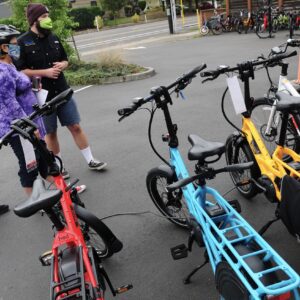

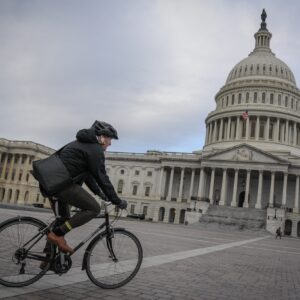

Thanks for reading.
BikePortland has served this community with independent community journalism since 2005. We rely on subscriptions from readers like you to survive. Your financial support is vital in keeping this valuable resource alive and well.
Please subscribe today to strengthen and expand our work.
Great article and photos. Can’t believe businesses are still against walkable/bikeable streets, it’s been proven to be good for business time and time again.
Thanks Gabe,
In this specific case, I don’t think its simple as business owners being against walking/biking… My hunch is that folks who are against the change are simply against the change.
This area has changed a lot and a dramatic shift in how the street looks/feels/operates understandably scares people.
For business owners, like Cha Cha Cha owner, I think it’s more of a lack of understanding about how transportation can work and a need to overcome personal/cultural bias against bicycling.
But yeah, I was very frustrated sitting in that meeting because there seems to be a general tone/vibe that the one-lane option is somehow a trade-off between what’s good for business/traffic flow/access and what’s not.
It needs to be made very clear to people that one-lane on Williams IS the pro-business/pro-access/pro-community solution!
Yeah, I hope that PBOT can sit down with the business owners and talk through that with them – that allowing great bike access can actually increase the number of people who can get to their businesses, reduce automobile congestion in the area making it easier for people using *all* modes to get to them, and increase the number of neighborhood residents who feel vested in their business.
Re-purposing space away from the movement of automobiles is still often seen as the “special interest” option, and that’s really too bad.
Just spent a couple weeks at the United Bicycle Institute about a block from Cha Cha Cha. Many of the students and instructors ate lunch there almost every day.
I don’t know if any of the customers I saw there arrived by car. Most days I ate there I know more than 1/2 the customers arrived on foot (like me although my bike brought me to the neighborhood) or on bike.
If PBOT wants to do what’s best for small business they’ll eliminate a car lane. It’s too bad all businesses don’t perceive this as a benefit.
I’m wondering why any business would oppose a plan to trade a bit of metal-box capacity for a more bikeable street. It’s not as if car traffic is being removed – there will still be a full lane for cars plus lots of subsidized parking
More people rolling through at human speed means more people becoming aware of Williams businesses.
They oppose it because they have not awoken to the reality that in the long run it will be good for everyone…
I would love to build a bike that is dedicated to cycle track sweeping, and I would totally go out and sweep these lanes, count me in!!
PBOT now has a choice: they can either honor the bike master plan, or they can leave it on the shelf and crap all over it.
If history is any indication, they will eventually cave in to business owners who regularly fight against any changes in the status quo.
In the three years I have been reading this blog, I have consistently disagreed with just about every comment you have ever posted to this site BURR. 😉
But I gotta say (and this is gonna be a first for me here) I’m with you the **whole way** on your comment here!
Couldn’t agree more. As someone who attended all kinds of bike master plan rides, open houses, etc etc etc, over the past couple years, it’s disheartening as a citizen to see the City gather all of this amazing input, stick it in a 600 page report, then stick it on a shelf and do nothing with it.
So yes, I really, really agree with you here. The City owes it to the thousands of people who dedicated their spare time and effort to being a part of / contributing to the Bike Master Plan, to honor it.
Projects like good bikeways on Vancouver Williams are ways to begin doing this.
One traffic and one bike lane is great, but a cycle track is neither needed nor warranted here.
I think we, and I have said this many times, should drop the cycle track and stick with bike lanes.
This is Portland, not Holland, and we ride with the traffic, not divided from it…..
Also, I think it is time for the City to let business owners know that some onstreet parking may be going by the wayside, in favor of more responsible ways of prambulating yourself around town…
Who’s *we*? I live here, and I prefer not to ride with traffic, thanks.
Well maybe move to Holland? I see from your blog you mahave a fascination with it anyway?
Or find yourself a nice MUP to lollygag on?
Here in Portland, we have traffic, and we ride next to it… if you don’t you are on a MUP, or not riding your bike. Traffic is everywhere, even on the 25 mile an hour streets through your neighborhood…
“We” I guess would be many people besides you then..
MLK and Grand are totally available to ride on for those that want that kind of experience. In the meantime I suspect you’re in the minority.
Lets cherry pick two of the busiest high-speed streets in PDX and draw erroneous conclusions, shall we. Like it or not, this is a city with a growing number of confident and fearless vehicular cyclists.
Holland has lots of cars, and they also ride in traffic when necessary. We in Portland ride in traffic because there’s no other choice, and why many people I know still won’t ride a bike.
I suspect that if all our streets offered physically separated cycle tracks that many of the people who currently cite traffic as a reason for not biking would simply find another reason not to bike. They don’t have showers at their offices, or they don’t like riding the rain, or they have to carry too much stuff into work… and so on.
Reducing mode conflict is worthwhile in its own right, just may not be the cure-all that gets everyone on their bikes.
I could not agree more.
Almost every one I know who rides the Broadway cycle track on a frequent basis is unhappy with the way the facility that boxes in cyclists and throws them into unavoidable conflict with pedestrians and buses.
Interesting. I’ve not seen any buses in the broadway cycle track, yet. But I see them in the Williams bike lane. 🙂
with all due respect, i doubt you ride the entire length of the cycle track often. during peak commuting hours the upper end of cycle track is frequently blocked by large and small buses. often the students boarding the buses also line up in the cycle track.
even worse at the top end of the cycle track the row of parked cars makes cyclists invisible and has created a dangerous right hook risk. i suspect it will take an injury for the city to take interest in the problem they created.
the numbers in the PSU survey conducted last year indicate signficant dissatisfaction (which is quite amazing given the usual enthusiasm for a shiny new facility). i would love to see this question posed again now. i suspect many of the cyclists who “like” the cycle track only use the first block or two as they exit to their jobs/classes at psu. likewise i suspect that the majority of those who ride the entire length of the cycle track are not at all happy.
I use the cycletrack at PSU frequently and I think that it is great. I ride Williams very frequently and I feel like there is lots of conflict with buses. I’m also a frequent pedestrian on Williams frequently and I have a difficult time crossing the street regularly- and I think that a road diet and specifically a cycletrack would be fantastic here.
+1
As someone who bikes Williams every day, I am not sure where I stand on reducing it to one auto lane. I LOVE it in theory, but I also have a hunch it will make car operators increasingly territorial.
Having just been honked/yelled at yesterday by a car driver while passing a biker by moving over to the car lane, i’m reluctant honestly. This occurred on Vancouver at Gantenbein where there are TWO auto lanes. Are we inviting more of this?
You won’t need to use the auto lane to pass if the bike lane is 10ft wide.
pdx cyclists tend to ride in the middle of facilities regardless of their width.
I’d venture to say that’s because there’s usually threat of moving cars on one side, and car doors on the other. I’d ride to the right if I weren’t worried about getting doored.
Ditto – I don’t ride in the door zone, period. Screw everyone else’s convenience – they can wait or go around. If the road isn’t designed so that a cyclist can ride outside the door zone and other traffic can get around, then PBOT needs to step up and redesign the road – maybe remove parking.
I wasn’t there so I don’t know the particulars, but it sounds like you made the pass by exiting the bike lane and entering the car lane, which is good, but did so when a car was there or approaching, which is bad. Number one rule for anyone passing anyone is not to do so unless it’s safe to do so. Live (hopefully) and learn (hopefully).
It’s safe to do so when the car is half a block back, and simply might have to slow for a brief moment while you complete the pass. It’s okay to leave the bike lane to pass, and people in cars should expect to occasionally have to slow down to allow such passing, just as they occasionally have to slow down for other people driving cars. But it is not uncommon to get a honk when I personally pass in this manner, simply because some people are jerks, and some of those jerks drive cars.
Swerving out of the bike lane and causing a person in a car to slow quickly is of course another issue entirely.
Did you signal that you were moving into the “car” lane? Was there enough room to move over without causing the honking driver to slam on his brakes? If yes to both, then the driver can suck it.
Drivers aren’t afraid of making me angry–they pull dumb crap every day, seemingly to try. The only reason we are afraid of making drivers “territorial” is because many of them drive like rabid dogs, and they have the ability to literally rip out our jugulars–if they are criminal sociopaths. If they are criminal sociopaths, they belong in jail or an institution.
Seriously, take this logic a little farther by asking these questions:
What do I do or want to do (while riding my bicycle) that I feel will make a driver angry? Is it something legal? Does it infringe on the driver’s rights (remember that driving, per se, is NOT a right)? If I need to do something while riding that is legal and adheres to known safety principles, why do I feel like the driver will become angry? Whose fault would it be if the driver did become angry?
Why does an angry driver make me fearful? Is it because I believe the driver will menace, threaten or otherwise assault me with his vehicle? What does this say about motor vehicles (not necessarily drivers)?
If I fear for my life because a driver actually does menace, threaten, or otherwise assault me with his vehicle, who is in the wrong? What does this say about such drivers?
Speaking of “inviting”, does a small child in line for the drinking fountain “invite” a bigger kid to shove him out of line and take cuts? Does the small kid “invite” being intimidated any more or less if there used to be two drinking fountains, but now one is out of order? How about if one drinking fountain, instead of being removed, was just lowered so smaller kids could reach it, leaving one fountain for big kids and one for little kids? Does this “invite” big kids to continue to hog both fountains, knocking smaller kids out of the way?
I’m all for being pragmatic from a self-preservation viewpoint, but I’m not going to take the blame for Motorist Anger, or consider it my duty to scurry like a mouse to stay “out of the way” of entitled drivers.
I love the water fountain analogy, by the way. Unfortunately, in this case the people doing the bullying don’t grasp that that’s what they’re doing. It’s not uncommon to be honked at or flipped off more or less just for being there, just for existing. Which brings to mind the times I’ve heard cyclists accused of havin a sense of “entitlement,” as if they weren’t. Entitled, that is. To be there, to exist.
One way we can make this more attractive for businesses is to make sure the plan includes a bike corral on every block in the business district.
Agreed. I’m surprised that the bike corral located at N Williams and Failing (east side) isn’t located in the center of the block in front of Ristretto Coffee/Cha Cha Cha/Eat Oyster Bar. I think that locating them around corner off of Williams detracts from making this area a focal point for bike-related business. (The other one also on Failing on the other side of Williams makes more sense since it is located more toward the front of The Fifth Quadrant. It also feels like it is in front of Pix.)
One other advantage of bike corrals is that the can improve visibility for car traffic. These might be helpful at a busy block in front of a bus stop where the stop would be located in the street with a cycle track between it and the sidewalk.
a corral onstreet on the right side could create pullout problems. much as i appreciate the additional bike parking in front of waypost, it is tricky getting in and out. i actually prefer putting the corral around the corner on failing.
Likely the opposite will happen as calming traffic usually calms the people in the traffic. Also, with a more adequately sized bike lane you won’t have to pass in a car traffic lane.
the mom and kid in the photo working their way left just north of failing should not have to cross two lanes to get there. in the existing configuration, since i largely disregard the striped bike lane anyway, for me this move would simply be from the right travel lane to the left, which is actually not at all difficult. if we are insisting on separated facilities, this would be a good argument for dedicating the right lane entirely to bikes. at the very least, PBoT should get rid of the striped bike lane through segment 4 and put down sharrows. but you and i know that is one thing they will absolutely not do (watch what happens on the 12th avenue bridge). so unless they are going to cave completely, as burr suggests, they pretty much have to take out a travel lane through segment 4, period.
Riding with a young child like that on the back of a bike and crossing lanes of traffic seems really risky. I would do a box turn.
I’m in total agreement with this. Make a comfortable 10′ – 12′ bike lane and forget about the cycle track.
+1
Let’s get our terminology straight, here. A 8 – 10′ bike lane should either be called either:
a “Dedicated Vancouverite Lane”
or
a “just-double-parking-my-Lexus-in-front-of-Tasty-and-Sons Lane.”
Once bike lanes get that wide, they get mighty attractive to park and drive in. That’s not the case with a well-built cycletrack.
so make it a shared bike-bus-right turn only lane instead, and the bus will keep it clear of double parked cars.
I have NEVER driven a car to Williams to eat or shop. I bike exclusively to that area, either stopping on the way home or swinging down after work or on weekends. Who does Cha!Cha!Cha! think it’s customers are, exactly? Assuredly not the motorists bypassing the interstate. Perhaps some letters from patrons are in order to help everyone see the business model.
I wholeheartedly agree. I go to the restaurants and shops on Williams on a regular basis. I have always been on my bike or on transit. I have never driven there.
Good idea.
Agreed. We’ll never get to double-digit bikeshare by throwing sharrows on a street where people drive 40 MPH. But perhaps not everyone wants that…
Which street(s) with sharrows routinely sees people driving 40mph?
Ankeny, Tillamook, Salmon, Taylor, Going…
… in other words, any bike boulevard in the city that parallels a major arterial. Bike boulevards in 2011 appear to function as little more than two extra lanes for speeding motorists who cannot be bothered to deal with waiting at lights on the busy arterials.
people may be going faster than you would like on the streets you name here, but they are not going 40
Occasionally, they are.
NW 18th and 19th. People go over 40 there at times.
The auto lanes on NW 18th and 19th are simply too wide. They need to be narrowed to control speeds. But those streets represent one of the first times we were able to remove auto lanes (underused ones to be sure) to put in bike lanes!
“Occasionally, they are.”
Which is why I asked about routinely; there are always exceptions. Are speeders the exception that prove the rule, a large minority or a majority? How fast are they going? Are bikes using those streets? Have sharrows helped increase bike share and awareness, there? Has the combination of sharrows and bike presence changed driving habits (“traffic calming”)?
Frequently, they are. Many of those streets have a number of serious speeders – you’ll see it sometimes on Clinton, especially east of 26th coming downhill.
Sorry, y’all,this comment wound up in the wrong spot. I intended to comment that a share the lane approach on williams would be problematic for increasing ridership, given motorists’ tendency to go fast on that road when given a chance. Good discussion, though.
As someone who enjoys the wondrous wonderfulness of bike commuting on Williams but also drives an enormous gas guzzling, space hogging SUV (man I love that thing… like a giant sofa), I am for the one lane solution. Cheaper, easier, better for cyclists and will produce less car on bike rage. Businesses are nuts if they can’t see that less/slower traffic makes the strip more pedestrian friendly. One lane = designer tea cozy shops and that sort of thing.
I like cozy streets, their nice and- well cozy. Lets fix the problem that puts all the cars on Williams and see how things change
You would think with so many cafes and restaurants opening up on that street with outdoor seating, businesses would be crying out for one, rather than two, lanes of obnoxious, loud, fume-spurting traffic.
You would also think, if car drivers wanted to get anywhere in a hurry, they would stick to MLK.
you would think if a car wanted to go somewhere quick they would jump on the freeway. But that needs fixed, so they drive on Williams because it is moving and the freeway is not
Instead of Williams people like me (when I’m driving home) should get in the habit of looping under around and under the Broadway Bridge to take Interstate home.
I didn’t say the freeway, I said MLK. Which does move along very nicely, thankyou very much! 😉
Which is why the solution is to make Williams less convenient for and less attractive to motorists. Then they will move over to MLK and back to the freeway. People as a group are generally lazy. If you make it easy to drive, they will – and they’ll take the shortest path they can to get there. The solution is not to build more lanes, even on the freeway – the collectors funnel everyone into the freeway, so if you add more lanes, not only will they fill up until the same level of congestion is reached, but you will increase congestion on all the arterials and collectors that those cars need to enter and leave the freeway.
The solutions are to reduce speeds, reduce lane widths, and reduce the number of lanes. Bring things back to human scale, slow things down, and make travel far less convenient so people as a group will make conscious choices about their options, time of travel, etc rather than just getting in the car on autopilot.
It’s interesting that businesses see the two-lane road as what brings them customers, as if all those people rushing home after work are really going to stop.
As someone who drives and cycles, I don’t usually (actually, ever) just randomly stop some place while I’m driving home after work because it just happened to be along my route. I’ll only stop if I have a planned stop (like a grocery store, or dinner with friends, etc).
I know my anecdotal opinion doesn’t replace actual statistics, but my gut feeling is that more people find businesses because they are actively looking for the service that they offer, say on the internet or in a phone book, rather than because they see it on a side road. Or because they heard about it from a friend, or saw a review on Yelp.
Making the street safer for everyone seems like a win-win to me.
I should add, since I forgot to in my previous comment, that if I find a business that has something I need, I’ll bike or drive there, no matter where it is. Downtown, east Burnside, weird industrial areas, wherever – the products or services are what matters, not what type of road it’s on.
Their fear is that people will not take their trip because of the congestion and hassle. This fear is not totally unfounded – my wife hates coming downtown if she’s driving (because of traffic, parking, etc). That said, if she’s got to go downtown, shell take the bus.
However if I see a shop that looks interesting and there is no parking I very well may keep on driving.
on-street parking won’t have much of an impact on this – you’re talking maybe a half-dozen car spaces. If there is nowhere to park within 2-3 blocks of a store, I don’t think the presence or absence of parking on Williams is the main factor in the problem.
PS – I agree with above posters. A cycletrack is expensive. Why not just reallocate roadspace with good old white paint?
Not that I’d be lying if I didn’t say. this looks pretty darn appealing too 😉 –
http://www.flickr.com/photos/lukehopkins/466490510/
there’s no way this would make it more difficult for people to get to businesses… it might make it more difficult for cars, but based on traffic volumes I doubt it…
so the most likely scenario is that this makes it easier for people to get to businesses, no matter what mode they use…
these old-school business owners need to wake up and realize they live on a bike street with too many cars and that cars are not the transportation of the future…
they stopped putting businesses on the freeway a long time ago for good reason… now lets start taking the freeways away from businesses…
The Cha Cha Cha on Bybee gave me a wretched case of food poisoning. Now I have an equally strong second reason to never patronize the Cha Cha Cha restaurants.
Potential salmonella aside, the business owner is simply trying to do what he thinks is best for his business. Hopefully he can be educated. Boycotting just as a new lane treatment goes into effect will only serve to reinforce his mistaken impression of the result of reducing Williams to one lane.
I guess I am confused with Williams. It receives a much higher volume of cycle users than a street like Holgate in SE Portland. Where the city reduced car lanes–against the wishes of both the business and residential communities–on a street with much less bike traffic, and does not really offer a real bike destination point.
So why is Williams different than Holgate?
Holgate is a neighborhood street (the vast majority of property on the street is residential) and it was overbuilt for the traffic level. The buffered lane conversion was partially out of convenience, but The lack of visible demand on holgate definitely led to problems with the community after they were installed.
Are the chachacha s owned by one person and managed separately or owned separately? Just wandering if the cha “owner” at the meeting was the person who runs the business; who I see almost every time I eat there. I would like to let him know that my kids and I would bike over for burritos much more often if there were biking conditions suitable for kids around 5-6pm. There was no email contact on the single cha cha cha website.
They made Interstate ave into a 1 lane road and it has been a backed up mess ever since. Just think about all those cars sitting there with their motors running, not moving. Hardly efficient at all.
traffic counts on interstate are well over 20k. traffic counts on williams are under 10k except near the highway exits. apples and oranges. if taking out a lane on williams had the effect of backing up through traffic, and the through traffic went elsewhere, one of the stated objectives of this project would be accomplished. i would like to believe PBoT is stretching this out specifically for the purpose of getting this kind of feedback, to justify what they must know they have to do here.
When and where has it backed up? I don’t go up there very often, but when I do (via bicycle and automobile, during the weekend and weekdays) the one-lane roads seem to be moving smoothly along. If there are small sections that are backed up, it might be falling victim to people attempting to do cut-through to avoid a different congested area (and that’s no reason to penalize the people and businesses along Interstate Ave.)
I rarely find INterstate Ave backed up, but I confess I drive it rarely. Why? Because there is a big ole Max train to ride right up the middle. Which is why I live right off of Interstate, so I can ride a train to and from downtown.
I live near the yellow line also. I seldom go to downtown, and less seldom need to go to the EXPO center. Dont ride the max, do drive interstate. rush hr is prohibitive though
So do we have information on business owners position on this outside of Cha Cha Cha? I spend some money at these establishments and no longer own a car. I’d like to inform them about what value they can expect with such a change. I suspect they will be delighted when the streetscape is calmer and the business booming.
We actually have a considerable amount of business support for a one lane option. That side of the story will hopefully see the public light soon.
Is there any documentation to support (not opinion, actual statistically significant studies) the idea that businesses will be “booming” as a result of a cycletrack conversion?
I cannot find any.
Please link.
What I have tread recently has more to do with parking. Not exactly what you are looking for but more bike parking=more bike traffic. (I don’t think cyle tracks specifily have been cited, but I have seen bike facilities in general cited.)
Elly’s recent column has a good round up of links. but generally, the more bike/ped friendly a business strip is the bigger influx of foot traffic an business you can get.
http://www.grist.org/biking/2011-04-11-the-economic-case-for-on-street-bike-parking
you might also search the Monday round ups here for other links.
When you arrive at these businesses by bike, tell them. That will help. When I travel to skateboard, I make sure I tell the biz owners ” I’m in town visiting the skatepark” as I spend my $$ at their establishment…has worked wonders over the years for relations in those small towns..
I don’t mean to sound anti-business because I frequent some of those businesses myself and appreciate their presence. But if particular businesses are going to be given special consideration for being located on the street, why not residents? I live on Williams. I know a dozen other bicyclists that live on Williams and we all want a safer street. Alas, we all either work, go to school full time or do both. No one has time to join a neighborhood association or take a day off work to make a ruckus at a city council meeting (unless you’re a boss and making a ruckus is a business interest).
It was reassuring to see such a significant change in what is now possible because we mobilized and made it clear we wanted a one-lane-all-the-way option ON the table, and early in the process. While our work is far from over, there are many lessons advocates can learn from how people-power can change the tenor of debate and in fact re-establish the scope and expectations of the public process. THANK YOU to those who were clear in their support for a better Segment 4 and a road diet, and please be ready to continue to shower support for safety improvements as the process moves forward.
Some of my quote highlights:
Owner of Cha Cha Cha: “We love bicycles, that’s why we moved to Williams…”
Owner of Anctil, on Williams for decades: “I was against bike lanes at first, now I absolutely love the bikes.. that’s why I bought more land across the street.”
Local resident who drives frequently: “Sometimes I drive on Williams so I don’t get stressed by traffic on I-5.”
Something should be done about Williams. I used to ride Williams all the way from Broadway up to Killingsworth but swore it off after numerous close calls. Either mark out a different bike route or get ride of one of the car lanes. I also used to drive up Williams all the time and getting rid of one of the car lanes wouldn’t be too much of a PITA. The big problem on Williams is all the traffic that comes off the Fremont Bridge, crosses Vancouver, goes left on Williams then lines up on Williams waiting to turn right on Fremont. Then, some idiot will leave a gap in traffic and some other idiot will drive right through without looking for bikes, other cars, or pedestrians.
Think about the reason they made this a 2 lane road to begin with? I’m not old enough to answer that one, but I would imagine there were good reasons to do that back then. Perhaps they needed to relieve the side streets from too much traffic? Do we really want to reverse this? Put those cars back to cutting through the side streets? I think that would be a bad idea.
As an inhabitant of N Williams Segment 4, I can say a lot of the ideas put forward here make sense, including this one. Thanks to everyone here who have contacted Ellen Vanderslice, the Mayor and others to petition for a more livable, people-friendly and human-scale Williams. My girlfriend and I appreciate it. =)